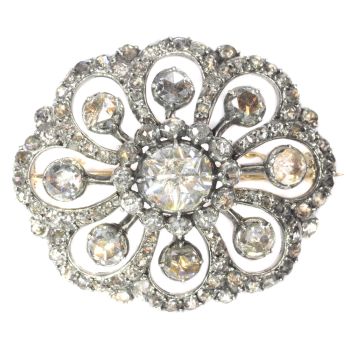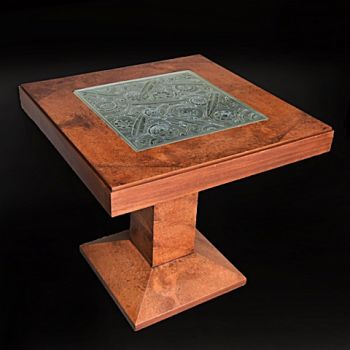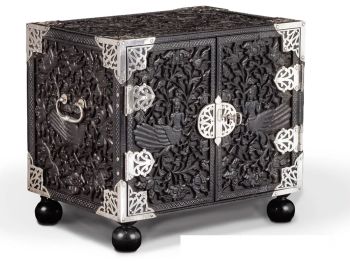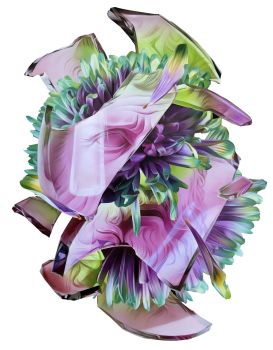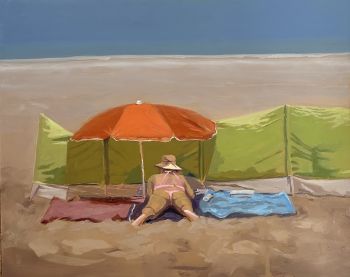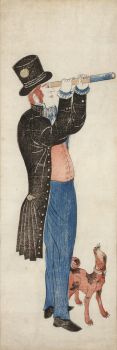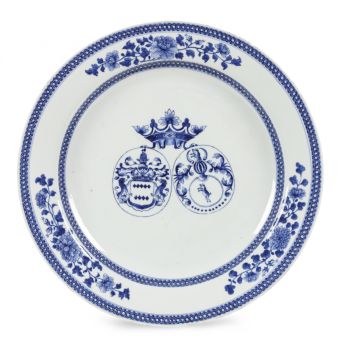An extraordinary pair of Indian ebony low chairs formerly owned by the Duke of Westminster Coromande 1680 - 1700
Unbekannter Künstler
EbenholzHolz
85 ⨯ 50 ⨯ 45 cm
Preis auf Anfrage
Zebregs & Röell - Fine Art - Antiques
- Über KunstwerkAn extraordinary pair of Indian ebony low chairs formerly owned by the Duke of Westminster
Coromandel coast, possibly Madras, 1680-1700
Both overall densely carved with an array of mermaids, birds, fish, mythological figures and floral and vine motifs, the back-rails are centered by a parrot (the attribute of Kama, the Hindu god of love) below a scallop shell (an attribute of Aphrodite/Venus) with a fleur-de-lis (a symbol of the Virgin Mary), the shell supported by two small human figures and a pair of mermaids, another Western element, but also a representation of the Hindu snake goddess Nagini, with crouching figures as finials, reminiscent of deity figures, with cane seatings.
H. 85 x W. 50.5 x D. 45 cm
Height of seat 41.5 cm
An identical chair is illustrated in Het Hollandsche Koloniale Barokmeubel, Dr. V. I. van de Wall, .1939, fig. 26. The Provenance of that chair is given as the Duke of Westminster, Eaton Hall, Chester. Before restoration the present pair had identical upholstered seats and the same casters as the chair of the Duke of Westminster. Therefore it seems safe to assume that the provenance of the present pair also is the Duke of Westminster, Eaton Hall in Chester. In the seat rails of the present chairs both are numbered II and III respectively, so they probably once belonged to a larger set in Eaton Hall.This type of chair usually turns up in England and seldom in Holland although they were also ordered by the Dutch on the Coromandel Coast of India. Possibly the Hindu motives of animals and humans in the carvings of these “Kust stoelen” were eventually not greatly appreciated in Muslin/Calvinist Java/Batavia. These high points in ebony furniture making were made by Hindu craftsmen in South India converted to Roman Catholicism by the Portuguese in the 16th and 17th centuries. These furniture makers, with their origins in the Hindu world, combined Hindu and Christian motives in a manner which was not seen again in furniture from India after the 17th century.
As in other known examples, the carving is in the round. The carvings on these two chairs bear close resemblance to the carving of the head- and foot-boards of the ebony rocking cradle in the Rijksmuseum Amsterdam (BK-1966-48, illustrated in: Asia in Amsterdam, 2015, cat. 26, p.108). - Über Künstler
Es kann vorkommen, dass ein Künstler oder Hersteller unbekannt ist.
Bei einigen Werken ist nicht zu bestimmen, von wem sie hergestellt wurden, oder sie wurden von (einer Gruppe von) Handwerkern hergestellt. Beispiele sind Statuen aus der Antike, Möbel, Spiegel oder Signaturen, die nicht klar oder lesbar sind, aber auch einige Werke sind überhaupt nicht signiert.
Außerdem finden Sie folgende Beschreibung:
•"Zugeschrieben …." Ihrer Meinung nach wohl zumindest teilweise ein Werk des Künstlers
•„Atelier von ….“ oder „Werkstatt von“ Ihrer Meinung nach eine Arbeit, die im Atelier oder in der Werkstatt des Künstlers, möglicherweise unter seiner Aufsicht, ausgeführt wurde
•„Kreis von ….“ Ihrer Meinung nach ein Werk aus der Zeit des Künstlers, das seinen Einfluss zeigt, eng mit dem Künstler verbunden, aber nicht unbedingt sein Schüler
•"Art von …." oder „Anhänger von ….“ Ihrer Meinung nach eine Arbeit, die im Stil des Künstlers ausgeführt wurde, aber nicht unbedingt von einem Schüler; kann zeitgenössisch oder fast zeitgenössisch sein
•„Art von ….“ Ihrer Meinung nach ein Werk im Stil des Künstlers, aber späteren Datums
•"Nach …." Ihrer Meinung nach eine Kopie (jegliches Datums) eines Werks des Künstlers
• „Unterzeichnet …“, „Datiert …“. oder „Beschriftet“ Ihrer Meinung nach wurde das Werk vom Künstler signiert/datiert/beschriftet. Das Hinzufügen eines Fragezeichens weist auf einen Zweifel hin
• „Mit Unterschrift …“, „Mit Datum …“, „Mit Aufschrift ….“ oder „Trägt Unterschrift/Datum/Beschriftung“ ihrer Meinung nach die Unterschrift/Datum/Beschriftung von jemand anderem als dem Künstler hinzugefügt wurde
Sind Sie daran interessiert, dieses Kunstwerk zu kaufen?
Artwork details
Related artworks
Artista Sconosciuto
UN RARO GRANDE TELESCOPIO GIAPPONESE IN PELLE LACCATA1750 - 1800
Prezzo su richiestaZebregs & Röell - Fine Art - Antiques
1 - 4 / 12Artista Sconosciuto
UN PICCOLO NETSUKE IN AVORIO DI UN OLANDESE CON UN TAMBURO1750 - 1800
Prezzo su richiestaZebregs & Röell - Fine Art - Antiques
Artista Sconosciuto
EIGHT NEO-GOTHIC STAINED GLASS WINDOWS WITH SUSPENSION EYELET, 19th C, BELGIUM.1850 - 1900
Prezzo su richiestaSpectandum Gallery
Artista Sconosciuto
UN NETSUKE IN AVORIO DI UN OLANDESE CHE GIOCA CON UN RAGAZZINO18th century
Prezzo su richiestaZebregs & Röell - Fine Art - Antiques
Artista Sconosciuto
UN NETSUKE IN AVORIO DI UN OLANDESE CHE TIENE UN GALLETTO18th century
Prezzo su richiestaZebregs & Röell - Fine Art - Antiques
Artista Sconosciuto
UN NETSUKE MARINO IN AVORIO DI UN OLANDESE CHE TIENE UN FAN . CINESE18th century
Prezzo su richiestaZebregs & Röell - Fine Art - Antiques
1 - 4 / 24Joseph Savart
Four portraits of women of Guadeloupe1769
Prezzo su richiestaZebregs & Röell - Fine Art - Antiques
1 - 1 / 1- 1 - 4 / 24
Artista Sconosciuto
UN INSOLITO PIATTO D'ARGENTO LOBBATO INDONESIlate 17th
Prezzo su richiestaZebregs & Röell - Fine Art - Antiques
Thea G.F. Eschauzier
Ritratto di una ragazza giavanese1931
Prezzo su richiestaZebregs & Röell - Fine Art - Antiques
Artista Sconosciuto
Olandesi in miniatura18th century
Prezzo su richiestaZebregs & Röell - Fine Art - Antiques
Wolfgang Hugo Rheinhold
“Eritis sicut Deus”1900 - 1950
Prezzo su richiestaZebregs & Röell - Fine Art - Antiques
Artista Sconosciuto
UN CONTENITORE PER DOCUMENTI DELLO SRI LANKA IN ARGENTO DORATO19th century
Prezzo su richiestaZebregs & Röell - Fine Art - Antiques
Artista Sconosciuto
A gem-set ivory sculpture of an Ottoman sultan1700 - 1750
Prezzo su richiestaZebregs & Röell - Fine Art - Antiques
1 - 4 / 12








